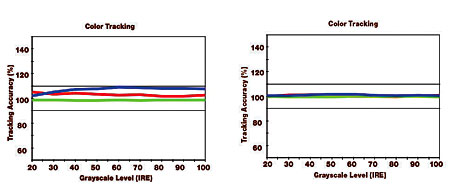Sony BRAVIA KDL-55XBR8 LCD HDTV HT Labs Measures
Black: 0.000
White: 38.64
Full-On/Full-Off Contrast Ratio: Infinite
For the picture adjustments used in this review, go to www.HomeTheaterMag.com. The measurements here were taken in the Custom Picture mode, through an HDMI input except as noted, with the set adjusted for the most accurate picture in a darkened room.

It was still possible to see a very low level of brightness on the screen with a full-screen black image. That is, the Sony’s black level is not truly zero, nor its peak contrast infinite. Rather, it’s unmeasurable with our Minolta LS-100 light meter—which simply means that the black level was below the meter’s 0.001 ft-L minimum sensitivity.

The Sony’s measured color performance was superb. While it was clearly a bit off before calibration, there isn’t much that needs to be said about the After result. The color gamut (with the Color Space control in Standard and Live Color off) is nearly a precise overlay of the HD standard.
The measured HDMI HD resolution was outstanding in 1080i/p (apart from the 1080p chroma resolution, which was merely fair), good at 720p, but poor in 480i/p. The latter failed to extend out to the limited frequency needed by standard-definition formats (6.75 MHz for 480i, 13.5 MHz for 480p). The Sony’s 720p component resolution was also poor and did not extend out to our maximum HD test frequency (37.1 MHz). Oddly, while the 480i/p component resolution was excellent, the 480i/p HDMI resolution was poor. (1080p component resolution was not tested.)
The bottom line: Use HDMI with this set for the best resolution in HD (1080i/p measures slightly better than 720p). If you connect any 480i/p sources, use them through a component input, not HDMI. Or, if you upconvert all sources to 1080i/p through an external player, receiver, or processor—and the latter do their job well—you’ll be fine.
The set’s overscan was zero on all sides in 1080i/p. In 720p it averaged 2.5 percent per side (an image loss of approximately 10 percent), and in 480i/p, it was just over 3 percent per side (just under a 12-percent image loss).—TJN
- Log in or register to post comments





























































